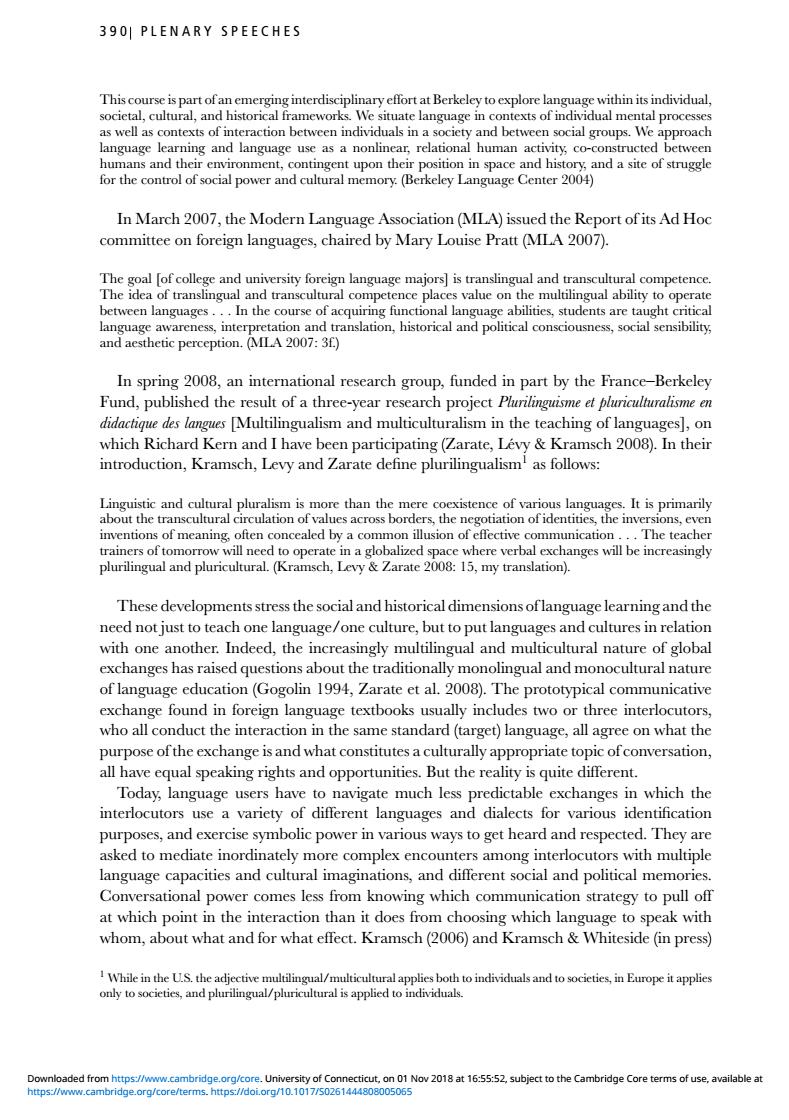正在加载图片...

3901 PLENARY SPEECHES at Berkeley toexpore language within its individual In March 2007,the Modern Lang age Association(MLA)issued the Report ofits Ad Ho committee on foreign languages,chaired by Mary Louise Pratt (MLA 2007). between languages In the course of acquiring functio al language abilities,students are taught critica cRa020036 anslation,historical and political consciousness,social sensibility. In spring 2008,an inte national research group,funded in part by the France-Berkele Fund,published the result of a three-year research project didactique des langues [Multilingualism and multiculturalism in the teaching of languages],on which Richard Kern and I have been participating (Zarate,Levy Kramsch 2008).In their introduction,Kramsch,Levy and Zarate define plurilingualism!as follows: and cultural pluralism is m re than the more cookistonce of lan s.It is primarily rculation es across bord lls the n tion of ident trainers of tomorrow will nced to ope in a globalized asingly plurilingual and pluricultural.(Kramsch.LevyZarate 2008:15,my translation) These developments stress the social and historical dimensions oflanguage learning and the need not just to teach one language/one culture,but to put languages and cultures in relation with one another.Indeed,the multilin xchanges has raised qu tions abc e traditiona ngual and monocultural natur of language education(Gogolin 1994,Zarate et al.2008).The prototypical communicative exchange found in foreign language textbooks usually includes two or three interlocutors, who all conduct the interaction in the same standard (target)language,all agree on what the purpose of the exchange is and what constitutes a culturally appropriate topic of conversation, all have equal speaking rights and oppo ortunities.But the re quite different Today,language users have to navigate much less predictable exchanges in which th interlocutors use a variety of different languages and dialects for various identification purposes,and exercise symbolic power in various ways to get heard and respected.They are asked to mediate inordinately more complex encounters among interlocutors with multiple language capacities and cultural imaginations,and different social and political memories 、a1 owing which strategy to pull off at which point n the interaction than it choosing which language ospeak with whom,about what and for what effect.Kramsch(2006)and Kramsch Whiteside(in press) nly to societies,and plurilingual/pluricultural is applied to w 2018 at 16:55:52,subject to the Cambridge Core terms of use,390 PLENARY SPEECHES This course is part of an emerging interdisciplinary effort at Berkeley to explore language within its individual, societal, cultural, and historical frameworks. We situate language in contexts of individual mental processes as well as contexts of interaction between individuals in a society and between social groups. We approach language learning and language use as a nonlinear, relational human activity, co-constructed between humans and their environment, contingent upon their position in space and history, and a site of struggle for the control of social power and cultural memory. (Berkeley Language Center 2004) In March 2007, the Modern Language Association (MLA) issued the Report of its Ad Hoc committee on foreign languages, chaired by Mary Louise Pratt (MLA 2007). The goal [of college and university foreign language majors] is translingual and transcultural competence. The idea of translingual and transcultural competence places value on the multilingual ability to operate between languages . . . In the course of acquiring functional language abilities, students are taught critical language awareness, interpretation and translation, historical and political consciousness, social sensibility, and aesthetic perception. (MLA 2007: 3f.) In spring 2008, an international research group, funded in part by the France–Berkeley Fund, published the result of a three-year research project Plurilinguisme et pluriculturalisme en didactique des langues [Multilingualism and multiculturalism in the teaching of languages], on which Richard Kern and I have been participating (Zarate, Levy & Kramsch 2008). In their ´ introduction, Kramsch, Levy and Zarate define plurilingualism1 as follows: Linguistic and cultural pluralism is more than the mere coexistence of various languages. It is primarily about the transcultural circulation of values across borders, the negotiation of identities, the inversions, even inventions of meaning, often concealed by a common illusion of effective communication . . . The teacher trainers of tomorrow will need to operate in a globalized space where verbal exchanges will be increasingly plurilingual and pluricultural. (Kramsch, Levy & Zarate 2008: 15, my translation). These developments stress the social and historical dimensions of language learning and the need not just to teach one language/one culture, but to put languages and cultures in relation with one another. Indeed, the increasingly multilingual and multicultural nature of global exchanges has raised questions about the traditionally monolingual and monocultural nature of language education (Gogolin 1994, Zarate et al. 2008). The prototypical communicative exchange found in foreign language textbooks usually includes two or three interlocutors, who all conduct the interaction in the same standard (target) language, all agree on what the purpose of the exchange is and what constitutes a culturally appropriate topic of conversation, all have equal speaking rights and opportunities. But the reality is quite different. Today, language users have to navigate much less predictable exchanges in which the interlocutors use a variety of different languages and dialects for various identification purposes, and exercise symbolic power in various ways to get heard and respected. They are asked to mediate inordinately more complex encounters among interlocutors with multiple language capacities and cultural imaginations, and different social and political memories. Conversational power comes less from knowing which communication strategy to pull off at which point in the interaction than it does from choosing which language to speak with whom, about what and for what effect. Kramsch (2006) and Kramsch & Whiteside (in press) 1 While in the U.S. the adjective multilingual/multicultural applies both to individuals and to societies, in Europe it applies only to societies, and plurilingual/pluricultural is applied to individuals. https://www.cambridge.org/core/terms. https://doi.org/10.1017/S0261444808005065 Downloaded from https://www.cambridge.org/core. University of Connecticut, on 01 Nov 2018 at 16:55:52, subject to the Cambridge Core terms of use, available at